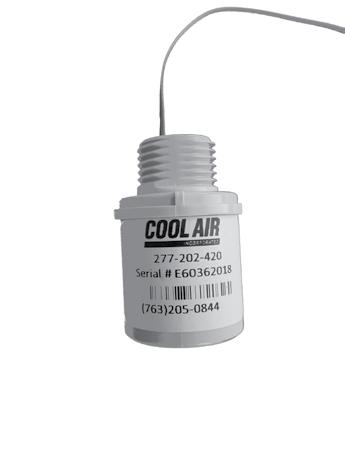
7 minute read
Government Relations
“The switch shall provide off-only control of refrigerant compressors, refrigerant pumps, and normally closed automatic refrigerant valves that are not part of an emergency control system, located in the machinery room. The function of the switch shall be clearly marked by signage near the controls.” • Construction of ammonia machine rooms sometimes lacks what is stated in Chapter 6. The following are a few key paragraphs: 6.2.1 Separation and Fire Protection. The machinery room shall be separated from the remainder of the building by tight-fitting construction having a onehour fire-resistance rating. Doors shall comply with Section 6.10. 6.10.2 Door Features. Machinery room doors shall be self-closing and tight fitting. Doors that are part of the means of egress shall be equipped with panic hardware and shall be side hinged to swing in the direction of egress for occupants leaving the machinery room. Where the machinery room is not provided with fire sprinklers, doors communicating with the building interior shall be one-hour fire-rated. Doors to the outdoors shall be fire rated where required by the Building Code based on the fire rating required for exterior wall openings.
To help in understanding of what constitutes a tight-fitting door there is a definition in ANSI/IIAR 1-2017 Definitions and Terminology Used in IIAR Standards.
“tight-fitting door: A tightly constructed door with seals to minimize gap clearances between the entire door perimeter and its fixed door frame that is intended to control the transfer of liquid, moisture, air, and vapor.”
A large percentage of machine rooms do not have tight-fitting doors. Many could easily accommodate a mouse, and I am sure ammonia molecules would have no problem escaping. Similar to the doors, numerous machine rooms do not properly address the penetrations through the machine room envelope, as they should as stated in the following paragraph: 6.6.2 Pipe Penetrations. Pipes penetrating the machinery room separation shall be sealed to the walls, ceiling, or floor through which they pass in accordance with Section 6.2.1. Where Section 6.2.1 requires that the separation have a fire rating, pipe penetrations shall be fire stopped in accordance with the Building Code.
There are several other key features that should be part of a properly constructed ammonia refrigeration machine room in Chapter 6 of ANSI/IIAR 2 2014 Addendum A. As an ammonia refrigeration designer, engineer, contractor, operator, etc. each should study and understand what is included in this ANSI/IIAR Standard. And, you should pass your understanding along to those who may not know.
If you don’t know does it matter? Yes it does.
The IIAR-2 Academy of Natural Refrigerants certificate course provides a comprehensive review of the standard. The course is offered online to provide easy access to match anyone’s schedule.
THE WAIT IS OVER! Cool Air Incorporated's Electrochemical Sensor
The choice is yours... Now each of our feature rich ammonia leak detectors can be fitted with either our long lasting, inexpensive, ammonia solid state sensor or with our NEW, highly selective ammonia electrochemical sensor. Retrofittable to any Cool AirInc leak detector in the field today (some older detectors may require a new control board)
Able to remote the sensor up to 500 feet from the detector High selectivity to NH3
Temperature compensated design
Excellent durability to NH3 exposure Long life
Three-year warranty
MARCH 28-31, 2021


PALM SPRINGS, CA


CSB Establishes New Chemical Incident Reporting Rule

government

RELATIONS
BY LOWELL RANDEL, IIAR GOVERNMENT RELATIONS DIRECTOR
n February 5, 2020, the Chemical Safety and Hazard Investigation Board (CSB) released its Final Rule on accidental chemical release reporting. The rule creates a new reporting requirement for facilities that experience a chemical release. The enabling legislation that established the CSB included a requireO
In December 2019, the CSB published a Proposed Rule that would comply with the court order and establish a new reporting requirement. IIAR, along with many others in industry, responded to the Proposed Rule commenting on the proposed provisions in an effort to minimize duplication and reporting burden for regulated facilities. The Final Rule released in February 2020 incorporates some of the recommendations made by IIAR and others, but fundamentally
In December 2019, the CSB published a Proposed Rule that would comply with the court order and establish a new reporting requirement. IIAR, along with many others in industry, responded to the Proposed Rule commenting on the proposed provisions in an effort to minimize duplication and reporting burden for regulated facilities.
ment that the agency develop a reporting mechanism to help identify incidents that warrant CSB investigation. While the legislation was enacted in 1990, and the CSB began operating in 1998, the agency had never finalized the reporting requirement included in the authorizing legislation.
Because the CSB receives reports of chemical releases from multiple sources, including the National Response Center (NRC), finalizing the reporting rule was not previously determined to be a priority. However, a legal challenge was brought against the CSB to compel them to finalize a reporting rule and the U.S. District Court for the District of Columbia ordered the CSB to complete a rulemaking by February 2020. moves forward with the creation of an additional reporting requirement that IIAR members must recognize.
KEY PROVISIONS OF THE FINAL RULE The owner or operator of a facility must report any accidental chemical release resulting in a fatality, serious injury or substantial property damage. Serious injury is defined as any injury or illness that results in death or inpatient hospitalization. This definition was refined between the Proposed Rule and the Final Rule in response to comments made by IIAR and others that expressed concerns that the original definition was too broad and would capture minor incidents outside the interest of the CSB. Substantial property damage is defined as estimated property damage at or outside the stationary source equal to or greater than $1,000,000.
Given the definitions of “serious injury” and “substantial property damage”, it is likely that many releases IIAR members must report to the NRC may not fall under the requirements for CSB reporting. The current reportable quantity threshold for NRC reporting is 100 pounds over a 24-hour period. Many accidental ammonia releases that are stopped small and well-contained do not result in “serious injury” or “substantial property damage”. However, it is critical that IIAR members understand the new requirements and report to the CSB when applicable.
The Final Rule specifies that facilities will have 8 hours to report a covered incident to the CSB. This is an improvement over the Proposed Rule, which suggested a deadline of only 4 hours to make the report. In its comments to the CSB, IIAR expressed concerns that 4 hours was insufficient, as facilities are focused on emergency response in the first hours of an incident. Thankfully, the CSB acknowledged the need for additional time for reporting and extended the timeframe to 8 hours in the Final Rule.
CONTENTS OF THE REPORT The report required under the Final Rule must include the following information regarding
an accidental release as applicable:
(a) The name of, and contact information for, the owner/operator
(b) The name of, and contact information for, the person making the report
(c) The location information a nd facility identifier
Engineering Excellence. Unrivaled Expertise.
RWF II 177 Compressor Package with package-mounted VSD pDrive ™


Food Grade Series AcuAir Air Handler with Quantum ™ HD Unity
LZW II Heat Exchanger
Rotary Screw Compressor Packages
offer a blend of efficiency, long-lasting reliability, ease of service, and top-tier technology.
Capable of delivering the industry’s lowest lifecycle cost, FRICK ®
screw compressors help you get the most out of your industrial refrigeration system.
AcuAir ®
Hygienic Air Handler
provides temperature, pressure and humidity control for the processing environment. Precision engineered and built to meet the food processing requirements of the USDA.
Quantum ™ HD Unity control maintains your working space conditions in the most precise and economical manner.
LaZerWeld ™
II Heat Exchanger

features two-piece gasket design to save PSM cost and allow two different types of refrigerants on each side.
The plate pairs have double laser welds providing an extra layer of protection for cross contamination.
©2020 Johnson Controls International PLC - All rights reserved.










